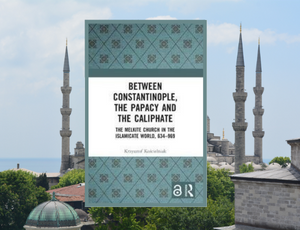

 Web Content Display
Web Content Display
Web Content Display
Web Content Display
 Web Content Display
Web Content Display
Web Content Display
Web Content Display

 Navigation
Navigation
Navigation
Navigation
 Web Content Display
Web Content Display
Web Content Display
Web Content Display

This volume examines the Melkite church from the Arab invasion of Syria in 634 until 969. The Melkite Patriarchates were established in Antioch, Jerusalem and Alexandria and, following the Arab campaigns in Syria and Egypt, they all came under the new Muslim state. Over the next decades the Melkite church underwent a process of gradual marginalization, moving from the privileged position of the state confession to becoming one of the religious minorities of the Caliphate. This transition took place in the context of theological and political interactions with the Byzantine Empire, the Patriarchate of Constantinople, the Papacy and, over time, with the reborn Roman Empire in the West. Exploring the various processes within the Melkite church this volume also examines Caliphate–Byzantine interactions, the cultural and religious influences of Constantinople, the synthesis of Greek, Arab and Syriac elements, the process of Arabization of communities, and Melkite relations with distant Rome.
KRZYSZTOF KOŚCIELNIAK. Between Constantinople, the Papacy, and the Caliphate. The Melkite Church in the Islamicate World, 634-969. London: Routledge DOI https://doi.org/10.4324/9781003253006 [Między Konstantynopolem, papiestwem i kalifatem. Kościół melKicki w islamizowanym świecie, 634-969]
Monografia analizuje kondycję kościoła melkickiego od arabskiej inwazji na Syrię w 634 do bizantyjskiej rekonkwisty Antiochii w 969 roku. Patriarchaty Melkickie Antiochii, Jerozolimy i Aleksandrii znalazły się pod panowaniem nowego państwa muzułmańskiego. W ciągu następnych dziesięcioleci kościół melkicki ulegał stopniowej marginalizacji, przechodząc z uprzywilejowanej pozycji wyznania państwowego do jednej z mniejszości religijnych kalifatu. Przejście to miało miejsce w kontekście interakcji teologicznych i politycznych z Cesarstwem Bizantyjskim, Patriarchatem Konstantynopola, papiestwem, a z czasem z odrodzonym Cesarstwem Rzymskim na Zachodzie. Zgłębiając różne procesy zachodzące w kościele melkickim, niniejszy tom analizuje również interakcje z kalifatem i Bizancjum, wpływy kulturowe i religijne Konstantynopola, syntezę elementów greckich, arabskich i syryjskich, proces arabizacji społeczności melkickich oraz relacje melkickie z odległym Rzymem.